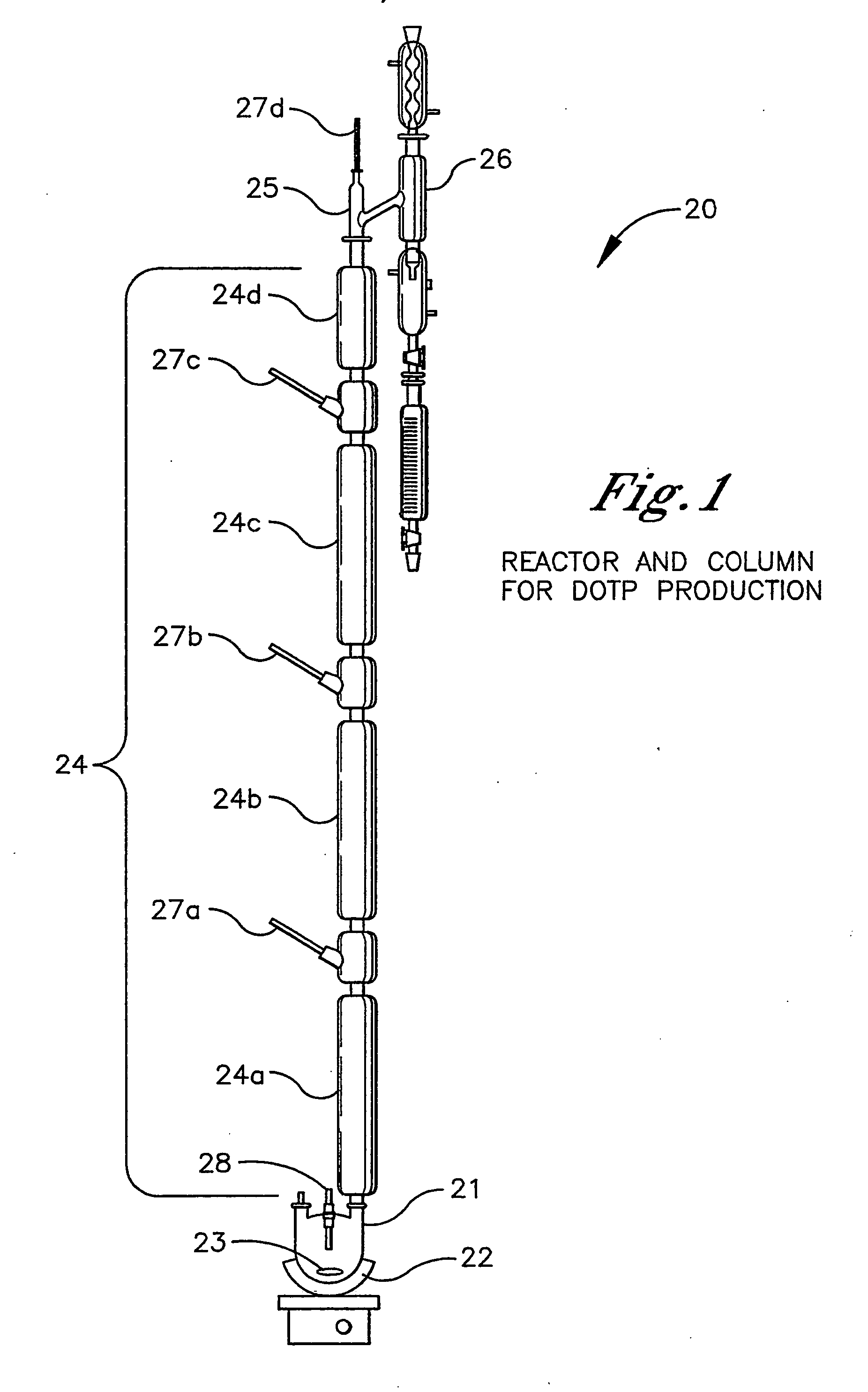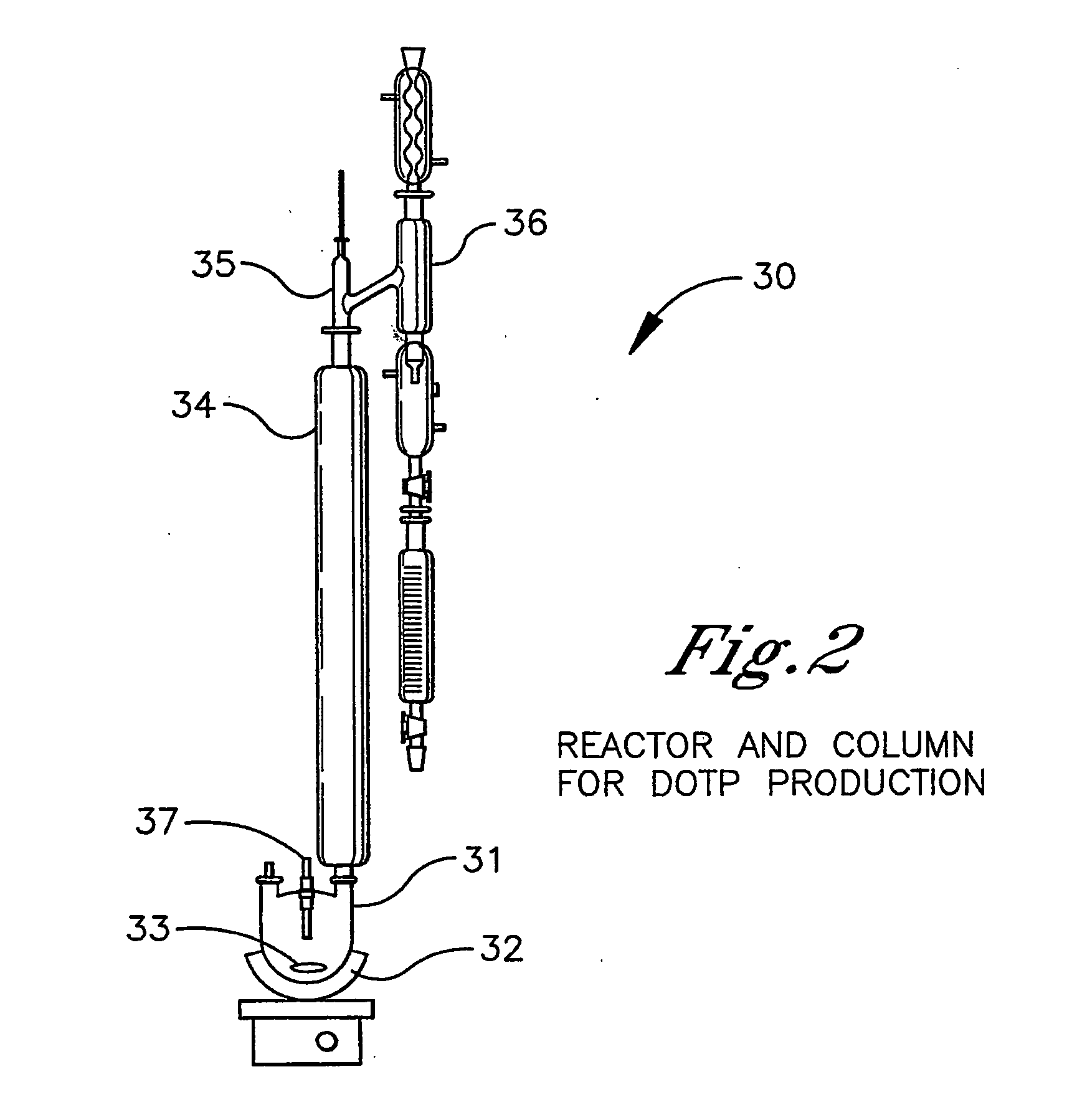Production of terephthalic acid di-esters
- Summary
- Abstract
- Description
- Claims
- Application Information
AI Technical Summary
Benefits of technology
Problems solved by technology
Method used
Image
Examples
example 1
[0024] A 500 milliliter autoclave was charged with 137.9 g (0.83 mole) TPA, 250 g (1.92 moles) EH and 125 ppm (0.048 g) TIPT catalyst. The autoclave was equipped with a stirrer, a conduit for feeding EH and nitrogen below the surface of the TPA / EH catalyst mixture, a pressure relief conduit and a conduit fitted with a control valve (backpressure regulator) for the removal of water and EH. The autoclave then was sealed and heated to approximately 180° C. to generate a pressure of 1 barg within the autoclave. As the reaction proceeded, a mixture of water and EH was removed and the EH was pumped back to the autoclave. Nitrogen was fed with the recycled EH to facilitate removal of water. Total reaction time was 10.5 hours at a maximum temperature of 260° C. and a maximum autoclave pressure of approximately 3 barg. Unreacted TPA (14 g) was recovered by filtration. The crude product then was neutralized with 2.5% aqueous NaOH, washed with water and filtered. Excess EH was stripped off at ...
example 2
[0025] A comparative experiment was performed at atmospheric pressure. To a 2-liter, round-bottom flask equipped with overhead stirrer, thermometer, heating mantel and vapor decanter was added 350 g (2.107 mol) of TPA, 687 g (5.28 mol) of EH and 0.208 g (200 ppm) of TIPT. Upon heating, the reaction began at 180° C. The temperature slowly reached 189° C. in 6 hours. A temperature of 202° C. was achieved after 10 hours reaction time. The temperature was held at about 205° C. until ˜14 hours of reaction time were completed. The temperature then reached 210° C. at 15 hours, 222° C. at 18 hours and the final temperature was 230° C., where it was held for 2 hours. A reaction time of 21.5 hours was therefore required before water evolution slowed to the point that the reaction was discontinued. A total of 73.5 g of water-containing distillate was collected out of a theoretical amount of 75.8 g. The crude product was stripped of volatiles, giving a total of 125.3 g. The residue weighed 733....
example 3
[0026] The reactor system and associated distillation column 20 is illustrated in FIG. 1. The equipment consisted of a one-liter base 21 fitted with a heating mantel 22, magnetic stirrer bar 23, temperature sensor 27, and distillation column 24. The attached column consisted of four sections 24a-d of all-glass, vacuum-jacketed Oldershaw columns with temperature sensors at each section 27a-d. The top of the column 24 was fitted with a head 25 to allow the water-2-ethylhexanol azeotrope to condense and collect in a decanter 26. The top 2-ethylhexanol layer was returned to the column via an overflow tube, and the water collected for weighing.
[0027] The reactor column one-liter base 21 was charged with 343.48 g (2.637 moles 25 mole % excess, MW=130.23) of 2-ethylhexanol, 1.054 mole (175 g, MW=166.13) of purified terephthalate (PTA), and 200 ppm (0.1037 g) of tetraisopropoxy titanate (TIPT). The decanter 26 was charged with 36.6 g of 2-ethylhexanol to make up for removal of the 25 mole ...
PUM
| Property | Measurement | Unit |
|---|---|---|
| Temperature | aaaaa | aaaaa |
| Percent by mass | aaaaa | aaaaa |
| Angle | aaaaa | aaaaa |
Abstract
Description
Claims
Application Information
 Login to View More
Login to View More - R&D
- Intellectual Property
- Life Sciences
- Materials
- Tech Scout
- Unparalleled Data Quality
- Higher Quality Content
- 60% Fewer Hallucinations
Browse by: Latest US Patents, China's latest patents, Technical Efficacy Thesaurus, Application Domain, Technology Topic, Popular Technical Reports.
© 2025 PatSnap. All rights reserved.Legal|Privacy policy|Modern Slavery Act Transparency Statement|Sitemap|About US| Contact US: help@patsnap.com


